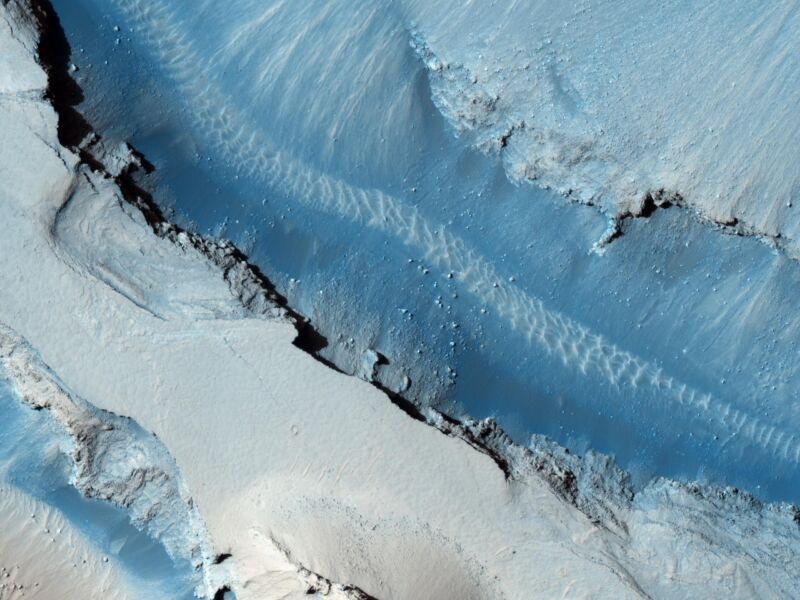

Marsquakes, recent volcanism suggest Mars still has a mantle plume
source link: https://arstechnica.com/science/2022/12/marsquakes-recent-volcanism-suggest-mars-still-has-a-mantle-plume/
Go to the source link to view the article. You can view the picture content, updated content and better typesetting reading experience. If the link is broken, please click the button below to view the snapshot at that time.
Hot stuff —
Marsquakes, recent volcanism suggest Mars still has a mantle plume
Elysium Planitia may be best explained by the same process that powers Yellowstone.
John Timmer - 12/7/2022, 12:30 PM

The Mars InSight lander included the first seismograph placed on the red planet, and it has picked up everything from marsquakes to impacts and provided lots of new information on Mars' interior. But perhaps its most striking finding has been that almost all of Mars' seismic activity appears to originate from a single location, a site called Elysium Planitia.
That area is also the site of the most recent volcanic activity we've detected on Mars. In a paper released this week, scientists argue that both derive from a single source: a plume of hot material rising through the mantle. It's the sort of geological activity that creates hotspots like Iceland and Yellowstone on Earth, but it had been thought that Mars had cooled too much to support those activities.
Building a case
Elysium Planitia is a generally flat region covering roughly a million square kilometers. It's just at the edge of Mars' northern lowlands, but it sits nearly a kilometer above them. Many of its features are old, including a series of ridges thought to be caused by the compression of Mars' interior as it cooled. But it also has signs of recent volcanic activity, though not nearly as much as the nearby Tharsis region, which contains Mars' largest volcanoes.
Instead, there are signs of large floods of volcanic material released from large fissures in Elysium Planitia. There are also signs of pyroclastic flows that appear to be the product of the most recent volcanic activity on the red planet, dating from less than 200,000 years ago.
AdvertisementThose signs made it interesting to scientists and one of the reasons that the InSight lander was sent to the area. And, as far as we've been able to tell, all of the significant marsquakes come from this area.
Obviously, the volcanic activity and marsquakes are likely to be connected. The question is how.
There are some potential explanations for these and other features of Elysium Planitia, but the researchers argue that a hot mantle plume is the only one that makes sense. "While alternative explanations may exist for some of these observations," they write, "only an active mantle plume can account for all of them."
It’s a plume
As mentioned above, Elysium Planitia has a series of fractures that are typically associated with compression, and these are thought to be a product of old terrain that's subsiding as the interior of Mars cools. But Elysium Planitia is also nearly a kilometer higher than the surrounding lowland terrain, suggesting that it might have been elevated by tectonic forces. There's also the Cerberus Fossae, a series of what appear to be volcanic vents, and the deposits that derive from them.
Those deposits are extensive, suggesting a major source of magma fed the activity in the region, which rules out some potential sources of the rock. While they're widespread, the deposits typically aren't thicker than about 100 meters, meaning they can't account for the area's elevation. And measures of the local variations in gravitational pull suggest the Elysium Planitia's elevation is supported from deep within the crust. Finally, the volcanic material in the area has much higher levels of iron than other areas of Mars, a feature found in volcanism driven by mantle plumes on Earth.
AdvertisementSo the researchers suggest that the region had been undergoing the normal contraction faulting that appears widespread across the surface of Mars. But more recently, a mantle plume reached the crust below it, elevating the region and adding the sorts of faults associated with the volcanic vents of Cerberus Fossae.
So they built a model of a mantle plume and adjusted it until it fit the region's various surface features and seismic data. Based on the model, they estimate the plume is about 4,000 kilometers in diameter, and it's about 200 to 500 kilometers thick in the area immediately beneath the crust. They also estimate that it's from 100 to 300 Kelvin hotter than the surrounding material.
How did this happen?
The activity levels found in Elysium Planitia are much lower than hotspot-driven sites elsewhere on Mars, and they're at the low end of what you'd see at similar sites on Earth. But the surprise is that it's happening at all. Earlier activity driven by mantle plumes should have removed some of the water from Mars' interior, making it more difficult for rocks to melt. The prior compression of the region should also make it more difficult for molten rock to force its way to the surface.
But, more critically, Mars' interior should have cooled significantly from the period when Mars built the massive volcanoes of Tharsis. In fact, some models of Mars' interior have suggested that this sort of activity should have ended by this point in the planet's history. So understanding what's going on here may be critical to improving those models.
Unfortunately, this is where the big glitch with InSight makes things difficult. It was supposed to deploy an implement that measures the heat flow from Mars' interior to its surface, which should have shed light on any hot material nearby (the InSight landing site is right on top of the proposed mantle plume). But the lander team couldn't get the instrument inserted into Mars and eventually abandoned attempts to get it to work.
But the new paper definitely suggests that Elysium Planitia is worth an additional look.
Nature Astronomy, 2022. DOI: 10.1038/s41550-022-01836-3 (About DOIs).
Recommend
About Joyk
Aggregate valuable and interesting links.
Joyk means Joy of geeK